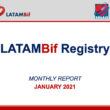Disease prevalence in patients with severe aortic stenosis is highly variable: from 80% in inoperable patients to only 15% according to the most recent research including low-risk patients. Given the high mortality observed in patients with heart disease, guidelines suggest considering coronary bypass revascularization in those in need of a valve replacement. This experience with...
The Most Read Articles in Interventional Cardiology during February
01- Efficacy of AstraZeneca’s Vaccine against COVID-19 This study, published in the Lancet, looks into the vaccine resulting from the collaboration of the Oxford University and AstraZeneca, among others. Read more HERE 02- Findings on Sputnik V Vaccine Against COVID-19 The Sputnik V vaccine was developed by Gamaleya NRCEM. Similarly to the Oxford-AstraZeneca vaccine, it is based on a viral vector,...
LATAMBif Registry: January 2021 Report
The Latin American Registry of Percutaneous Coronary Bifurcations continues to develop at a steady pace. The aim of this prospective multicenter registry is to assess the reality of percutaneous coronary bifurcation to define its needs and establish effective strategies to perfect the daily clinical practice. Bellow you will find data from January 2021, which includes...
Coronary Access After TAVR: A Potential Problem Ahead
Coronary cannulation after transcatheter aortic valve replacement (TAVR) was unsuccessful in almost 10% of patients. This problem occurred almost exclusively in those who received a self-expanding valve. This study, recently published in JACC Cardiovasc Interv., was sought to investigate the feasibility of coronary ostia access after TAVR and describe potential predictors of coronary access impairment....
The Most Read Articles of January in Interventional Cardiology
01- New Valvular Heart Disease Guidelines with Key TAVI and Mitral Regurgitation Updates Valvular heart disease management guidelines were updated last week by the AHA and the ACC. Read more HERE 02- High Risk Anatomy Challenges ISCHEMIA Outcomes According to this recent analysis published in JAHA, patients with stable Ischemic heart disease and high-risk anatomy benefit from revascularization...
Optimal Medical Treatment Under-used in Vascular Peripheral Disease
Less than half of patients undergoing endovascular revascularization for peripheral artery disease to their lower limbs are discharged with optimal medical treatment. Their traditional risk factors are predictors of a more comprehensive treatment; however, women, patients with higher risk of thrombosis, and those more likely to lose a lower limb, are far from being treated...
Pleiotropic Effect of Metoprolol: Different From other B-blockers
The clinical practice guidelines recommend the early use of endovenous B-blockers in patients undergoing acute myocardial MI, taking for granted that all B-blockers have a similar class effect. This experimental study might show metoprolol has other benefits that could make it superior to the rest of the B-blocker family. Using an animal model with 45-minute...
SOLACI PERIPHERAL | 5th Clinical Case: Abdominal Aortic Aneurysm with Hostile Neck
New clinical case from SOLACI PERIPHERAL! This time, we present a case featuring an abdominal aortic aneurysm with hostile neck. With this, we wrap up an intense year during which we published 5 clinical cases to deepen and stimulate the exchange between Latin American interventionist colleagues. Tell us what you think about this case using...
ProGlide vs. Prostar XL to Close Post-TAVR Access
Minimalist transcatheter aortic valve replacement (TAVR) is a strategy that is here to stay. We have previously published papers comparing local vs. general anesthesia, use of transthoracic vs. transesophageal echocardiography, and early discharge in TAVR. In all these papers, the “minimalist approach” included percutaneous closure of vascular access. However, few papers compare closure devices in...
The Most Relevant Articles in Coronary Disease in 2020
01- Virtual ACC 2020 | Controversial Trial ISCHEMIA Finally in NEJM In November 2019, during the American Heart Association (AHA) 2019 Scientific Sessions, researchers presented this revolutionary trial that called the attention of all cardiologists. We had to wait until March to read the fine print; back then, a global pandemic such as the current one seemed...








